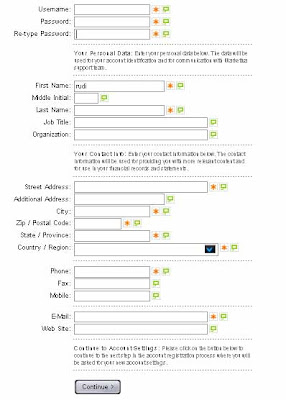Before you open a new account, you must to check marketiva price list and payment option and to read and understand the following policies marketiva adheres to regarding payment and anti money laundering processes.
One person can open one account only. In case marketiva administration system detects there are multiple accounts registered by the same person, such account will be suspended an the account holders will be required to provide supporting documentation. This policy was introduced as a response to many related misuses maketiva experienced in the past.
Open a new account in Marketiva
1. Click the banner first.

The front page of Marketiva
2. Click the tab "Open Account" and then a register form will be apear.
Please fill out the registration form.
After you finish fill out the registration form, click "Continue". Please fill out form below.
"User Template", choose Standard Setup.
"Coupon", we have some coupon here. You must only choose one.
Continue to terms acceptance, click Next.
check box service aggreement, and then click Finish
3. Verify your ID
After finish registration, you have to identify your self by upload some of your ID. (eq. lisence, identity card, passport). Remember just JPEG format.
Click here to direct link
4. Download software streamster marketiva. Click here
Read More..... »»
| Price List | Payment Option | Payment Policy | Anti Money Laundering |
One person can open one account only. In case marketiva administration system detects there are multiple accounts registered by the same person, such account will be suspended an the account holders will be required to provide supporting documentation. This policy was introduced as a response to many related misuses maketiva experienced in the past.
Open a new account in Marketiva
1. Click the banner first.
The front page of Marketiva
2. Click the tab "Open Account" and then a register form will be apear.
Please fill out the registration form.
After you finish fill out the registration form, click "Continue". Please fill out form below.
"User Template", choose Standard Setup.
"Coupon", we have some coupon here. You must only choose one.
PKHRCX5FO5,YUILCPJ79R,L51OEZSMUQ,NWKFOGVC0B,13UFB4IR5D,2FULJ5LDCM,
8QXUKEJUT7,EVCSKJJ67S,LHA5SQWA0Q,QEB1WEHS3K,K97H6NJAZD,V7XMZOBNJK, SNTJJ0L99C,W5R4MTWA9D,O99GL5FWKS,5FVKD2EQLR,WFDKM02Z07,A9USK79BJH, LT91P9TY1C,FFPO1Y0MS1,4AW54SQR32,IJWDKV80UD,GOIIKI76YB,NU4VD48TFV, K8DKKDQGWI,1OMOZB7MUY,L4M4OW98RY,U53LG32431,MXSCRWCRKW,
NW2BWD0YOS
8QXUKEJUT7,EVCSKJJ67S,LHA5SQWA0Q,QEB1WEHS3K,K97H6NJAZD,V7XMZOBNJK, SNTJJ0L99C,W5R4MTWA9D,O99GL5FWKS,5FVKD2EQLR,WFDKM02Z07,A9USK79BJH, LT91P9TY1C,FFPO1Y0MS1,4AW54SQR32,IJWDKV80UD,GOIIKI76YB,NU4VD48TFV, K8DKKDQGWI,1OMOZB7MUY,L4M4OW98RY,U53LG32431,MXSCRWCRKW,
NW2BWD0YOS
Continue to terms acceptance, click Next.
check box service aggreement, and then click Finish
3. Verify your ID
After finish registration, you have to identify your self by upload some of your ID. (eq. lisence, identity card, passport). Remember just JPEG format.
Click here to direct link
- Log on. Use your username and password.
- Click tab "service", and then click "Identify Yourself"
4. Download software streamster marketiva. Click here






















